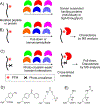Uncovering post-translational modification-associated protein-protein interactions
- PMID: 35334254
- PMCID: PMC9464464
- DOI: 10.1016/j.sbi.2022.102352
Uncovering post-translational modification-associated protein-protein interactions
Abstract
In living systems, the chemical space and functional repertoire of proteins are dramatically expanded through the post-translational modification (PTM) of various amino acid residues. These modifications frequently trigger unique protein-protein interactions (PPIs) - for example with reader proteins that directly bind the modified amino acid residue - which leads to downstream functional outcomes. The modification of a protein can also perturb its PPI network indirectly, for example, through altering its conformation or subcellular localization. Uncovering the network of unique PTM-triggered PPIs is essential to fully understand the roles of an ever-expanding list of PTMs in our biology. In this review, we discuss established strategies and current challenges associated with this endeavor.
Copyright © 2022 Elsevier Ltd. All rights reserved.
Conflict of interest statement
Figures


References
-
- Walsh CT, Garneau-Tsodikova S, Gatto GJ Jr: Protein posttranslational modifications: the chemistry of proteome diversifications. Angewandte Chemie International Edition 2005, 44:7342–7372. - PubMed
-
- Seet BT, Dikic I, Zhou M-M, Pawson T: Reading protein modifications with interaction domains. Nature reviews Molecular cell biology 2006, 7:473–483. - PubMed
-
- Sims RJ, Reinberg D: Is there a code embedded in proteins that is based on post-translational modifications? Nature reviews Molecular cell biology 2008, 9:815–820. - PubMed
-
- Deribe YL, Pawson T, Dikic I: Post-translational modifications in signal integration. Nature structural & molecular biology 2010, 17:666–672. - PubMed
Publication types
MeSH terms
Substances
Grants and funding
LinkOut - more resources
Full Text Sources
Miscellaneous

